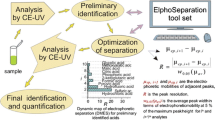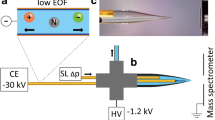Summary.
The work presented in this paper deals with the combination of capillary electrophoresis (CE) with electrospray mass spectrometry (MS) for the determination of drug residues in water. CE/MS methods have been developed based on either aqueous or non-aqueous ammonium acetate solutions as the carrier electrolyte for the separation of selected drugs. The different separation conditions were compared in terms of selectivity and detection limits; both aqueous and non-aqueous CE proved to be suitable for the present analytical task, exhibiting detection limits between 3 and 93 μg/dm3 (injected standard concentration) corresponding to concentrations between 5 and 19 ng/dm3 in the sample.
A combination of liquid-liquid extraction and solid-phase extraction was investigated for sample pretreatment, yielding enrichment factors of 10000. The applicability of CE/MS was demonstrated for the analysis of several river water samples.
Similar content being viewed by others
Author information
Authors and Affiliations
Additional information
Received August 25, 2000. Accepted October 17, 2000
Rights and permissions
About this article
Cite this article
Ahrer, W., Buchberger, W. Combination of Aqueous and Non-Aqueous Capillary Electrophoresis with Electrospray Mass Spectrometry for the Determination of Drug Residues in Water. Monatshefte fuer Chemie 132, 329–337 (2001). https://doi.org/10.1007/s007060170119
Issue Date:
DOI: https://doi.org/10.1007/s007060170119




